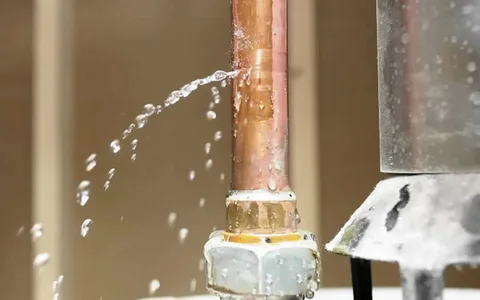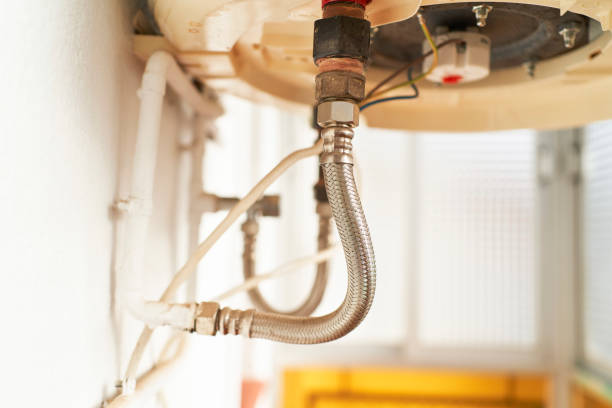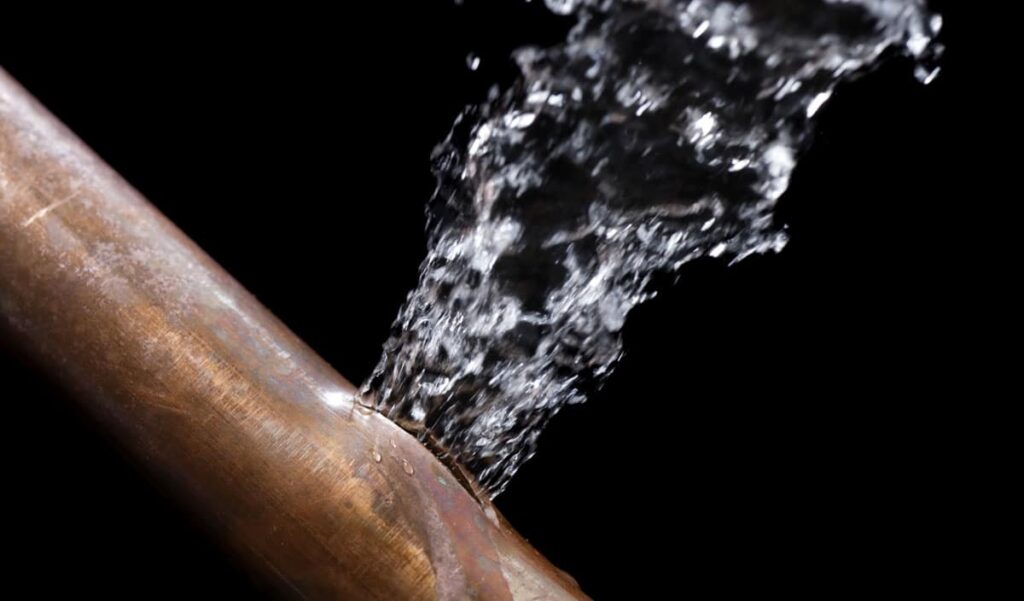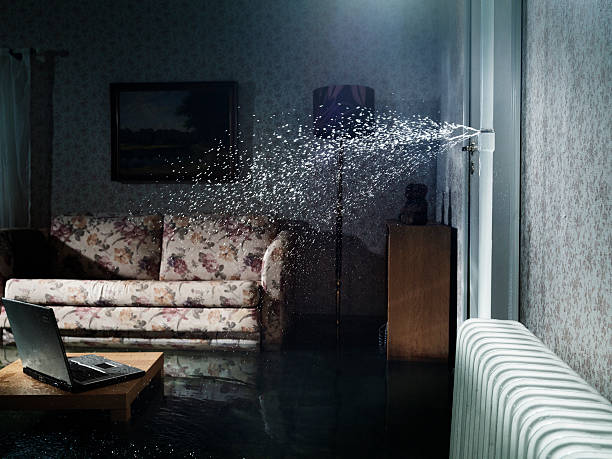Have you ever noticed a mysterious bulge or water leak in your ceiling after a professional painting company like Al Naser Paint finished transforming your living room? Or have you heard an unsettling, dripping sound echoing behind your walls? These could be signs of a sneaky culprit lurking in your home water leak.
Introduction
Water leaks are not just a common household problem; if left unaddressed, they can wreak havoc on your property and wallet. This comprehensive guide will equip you with the knowledge to identify, locate, fix, and prevent water leaks, keeping your home dry and saving you money in the long run.

Understanding Water Leaks: Types and Causes
Water leaks can occur anywhere in your plumbing system, from the pipes behind your walls to the fixtures you use daily. Let’s delve into the various types of water leaks and what causes them:
Slab Leaks
Slab leaks occur beneath your concrete foundation, making them particularly challenging to detect. Common causes include:
- Corrosion: Over time, pipes buried beneath the concrete slab can corrode due to constant soil moisture exposure.
- Shifting Foundation: Movement in your foundation can stress pipes, causing them to crack or break.
- Improper Installation: Faulty installation during construction can lead to weak spots in the pipes, making them susceptible to leaks.

Supply Line Leaks
Supply line leaks originate from the pipes that bring water into your home from the main city line. These leaks can happen due to:
- Freezing Temperatures: Water expands when freezes, and unprotected pipes can burst during cold snaps.
- Corrosion: Like slab leaks, exposed supply lines can corrode over time.
- Faulty Connections: Loose or damaged connections where the supply line meets the shutoff valve or the house can cause leaks.
Fixture Leaks
These leaks are more readily apparent at the taps, faucets, showerheads, toilets, and other appliances that utilize water. Common culprits include:
- Worn-out Gaskets and Seals: Over time, the rubber gaskets and seals within faucets and valves can deteriorate, allowing water to seep.
- Loose Connections: Like supply line leaks, loose connections at the base of faucets or toilets can cause dripping or spraying water.
- Cracked Fixtures: Heavy-handed use or extreme temperature changes can cause cracks in fixtures, leading to leaks.

Detecting the Silent Intruder: Signs of a Water Leak
Water leaks can be subtle or dramatic. Here are some key signs to watch out for:
- Increased Water Bill: A sudden spike in your water bill indicates a hidden leak somewhere in your plumbing system.
- The Sound of Running Water: If you hear the sound of running water even when no taps are on, it could be a sign of a leak.
- Water Stains and Discoloration: Look for water stains, warping, or peeling paint on walls, ceilings, or floors. These can indicate leaks behind walls or under floors.
- Mold and Mildew Growth: Mold and mildew thrive in damp environments. Their presence suggests a leak that’s been providing moisture for some time.
- Soft Spots on Floors: Standing water from a leak can cause the underlying flooring to become soft or spongy.
Taking Action: Addressing a Water Leak
If you suspect a water leak in your home, don’t delay! Here’s how to take immediate action:
- Turn Off the Water Supply: Locate the main shutoff valve for your home’s water supply and turn it clockwise to stop the water flow.
- Contain the Leak (If Possible): For small leaks, place a bucket or pan underneath the dripping area to collect the water and minimize damage.
- Call a Licensed Plumber: If you’re unsure about the source or severity of any significant leak, contact a licensed plumber immediately. A professional can diagnose the problem, locate the leak, and recommend the best course of action for repair.
Repairing the Damage: Solutions for Different Leaks
The approach to fixing a water leak depends on the type and location of the leak. Here’s a general overview of common repairs:
- Slab Leaks: Repairing slab leaks often involves locating the precise leak location, accessing the pipes through concrete cutting, and replacing the damaged section.
- Supply Line Leaks: Depending on the leak’s location, the plumber might need to replace a supply line section or repair the connection point.
- Fixture Leaks: Fixing leaky faucets or showerheads usually involves replacing worn-out gaskets or seals.
Preventing Future Floods: Leak Prevention Strategies
A stitch in time saves nine! Here are some proactive steps you can take to prevent water leaks in the first place:
- Regularly Inspect Plumbing Fixtures: Look for signs of wear and tear around faucets, toilets, and showerheads. Tighten loose connections and replace worn-out parts promptly.
- Insulate Exposed Pipes: Unheated areas like crawlspaces or attics are susceptible to freezing and bursting during cold weather. Insulate them with foam pipe sleeves to prevent this.
- Address Water Pressure Issues: High water pressure can stress your plumbing system and increase the risk of leaks. Consider installing a pressure regulator to maintain a safe and consistent water pressure level.
- Know Your Shutoff Valves: Familiarize yourself with the location of your main water shutoff valve and individual shutoff valves for specific fixtures. This will allow you to quickly turn off the water supply in case of a leak.
- Perform a Shutoff Valve Test: Practice turning off your main shutoff valve once a year to ensure it works properly. This will prevent any fumbling or delays in the event of an actual leak.
- Invest in Leak Detection Systems: Smart home leak detection systems can be installed to monitor for moisture and alert you to potential leaks before they cause significant damage.

Frequently Asked Questions (FAQs) About Water Leaks
Q: How much does it cost to repair a water leak?
A: The cost of repairing a water leak depends on the type, location, and severity. Minor leaks can cost a few hundred dollars, while significant leaks involving extensive pipe replacement or structural repairs can run into the thousands.
Q: Can I fix a water leak myself?
A: Simple leaks, such as those from a dripping faucet, might be manageable with basic DIY skills and readily available repair kits. However, for most leaks, especially those behind walls or under floors, it’s best to call a licensed plumber to ensure proper diagnosis and repair.
Q: What are the health risks associated with water leaks?
A: Mold and mildew growth, a common consequence of water leaks, can trigger respiratory problems, allergies, and skin irritation. Also, prolonged exposure to damp environments can exacerbate respiratory conditions like asthma.
Q: Who repairs a water leak between the house and the meter?
A: The responsibility for repairing leaks between the house and the meter varies depending on your location and local regulations. In some cases, the homeowner is responsible, while the water utility company might be responsible in others. It’s best to check with your local water authority to determine who is responsible in your area.
Conclusion: Be Water Leak Aware!
You can proactively protect your home from water damage by understanding the different types of water leaks, their causes, and the signs to watch out for. Taking preventive measures and acting swiftly when a leak occurs can save money, prevent structural damage, and maintain a healthy living environment. Remember, a little vigilance goes a long way in keeping your home dry and safe!
FAQs
Q: How much does it cost to repair a water leak?
A: The cost of repairing a water leak depends on the type, location, and severity. Minor leaks can cost a few hundred dollars, while significant leaks involving extensive pipe replacement or structural repairs can run into the thousands.
Q: Can I fix a water leak myself?
A: Simple leaks, such as those from a dripping faucet, might be manageable with basic DIY skills and readily available repair kits. However, for most leaks, especially those behind walls or under floors, it’s best to call a licensed plumber to ensure proper diagnosis and repair.
Q: What are the health risks associated with water leaks?
A: Mold and mildew growth, a common consequence of water leaks, can trigger respiratory problems, allergies, and skin irritation. Also, prolonged exposure to damp environments can exacerbate respiratory conditions like asthma.
Q: Who repairs a water leak between the house and the meter?
A: The responsibility for repairing leaks between the house and the meter varies depending on your location and local regulations. In some cases, the homeowner is responsible, while the water utility company might be responsible in others. It’s best to check with your local water authority to determine who is responsible in your areas.


